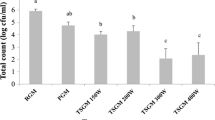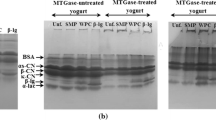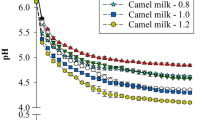Abstract
The aim of this study is to identify the chemical composition and the microstructure of the deposits obtained after heating camel and cow milks at 80 °C for 60 min using a laboratory-scale device. Like cow milk, camel milk was affected by heat treatment with the reduction of the non-casein nitrogen content reflecting the denaturation of camel whey proteins. The composition of the deposits generated during heating camel and cow milks at 80 °C for 60 min revealed that while camel deposit contained 57 % w/w protein, cow deposit showed a higher protein content of 69 % w/w. The mineral content was 35 % w/w for camel deposit which was higher than that of cow sample, which was 28 % w/w. SEM of both deposits showed a familiar structure of a protein deposit with large clumps composed of smaller aggregates. Camel deposit showed an amorphous structure due to its deficiency in β-lactoglobulin.



Similar content being viewed by others
References
Al-Haj, O. A., & Al-Kanhal, H. A. (2010). Compositional, technological and nutritional aspects of dromedary camel milk. International Dairy Journal, 20, 811–821.
Andritsos, N., Yiantsios, S. G., & Karabelas, A. J. (2002). Calcium phosphate scale formation from simulated milk ultrafiltrate solutions. Food and Bioproducts Processing, 80, 223–230.
Attia, H., Kherouatou, N., Nasri, M., & Khorchani, T. (2000). Characterization of the dromadery milk casein micelle and study of its changes during acidification. Le Lait, 80, 503–515.
Ayadi, M. A., Leuliet, J. C., Chopard, F., Berthou, M., & Lebouché, M. (2004). Electrical conductivity of whey protein deposit: xanthan gum effect on temperature dependency. Food and Bioproducts Processing, 82, 320–325.
Bansal, B., & Chen, X. D. (2006). A critical review of milk fouling in heat exchangers. Comprehensive Reviews in Food Science and Food Safety, 5, 27–33.
Boxler, C., Augustin, W., & Scholl, S. (2013). Fouling of milk components on DLC coated surfaces at pasteurization and UHT temperatures. Food and Bioproducts Processing, 91, 336–347.
Boxler, C., Augustin, W., & Scholl, S. (2014). Composition of milk fouling deposits in a plate heat exchanger under pulsed flow conditions. Journal of Food Engineering, 121, 1–8.
Burton, H. (1968). Deposits from whole milk in heat treatment plant—a review and discussion. Journal of Dairy Research, 35, 317–330.
de Jong, P. (1997). Impact and control of fouling in milk processing. Trends in Food Science and Technology, 8, 401–405.
Dubois, M., Gilles, K. A., Hamilton, J. K., Rebers, P. A., & Smith, F. (1956). Colorimetric method for determination of sugars and related substances. Analytical Chemistry, 28, 350–356.
El-Agamy, E. I., Abou-Shloue, Z. I., & Abdel-Kader, Y. I. (1998). Gel electrophoresis of proteins, physicochemical characterization and vitamin C content of milk of different species. Alexandria Journal of Agricultural Research, 43, 57–70.
El-Agamy, E. I., Nawar, M., Shamsia, S. M., Awad, S., & Haenlein, G. F. W. (2009). Are camel milk proteins convenient to the nutrition of cow milk allergic children ? Small Ruminant Research, 82, 1–6.
Farah, Z. (1986). Effect of heat treatment on whey proteins of camel milk. Milchwissenschaft, 41, 763–765.
Felfoul, I., Lopez, C., Gaucheron, F., Attia, H., & Ayadi, M. A. (2015). Fouling behavior of camel and cow milks under different heat treatment. Food and Bioprocess Technology, 8, 1771–1778.
Gaucheron, F., Le Graët, Y., Piot, M., & Boyaval, E. (1996). Determination of anions of milk by ion chromatography. Le Lait, 76, 433–443.
Gotham, S. M. (1990). Mechanisms of protein fouling of heat exchangers, Ph. D. thesis. UK: University of Cambridge.
Hassan, Z. M. R., Farahat, A. M., & Abd Elgawad, M. A. (2009). Effect of cold storage and heating of camel’s milk on functional properties and microstructure in comparison with cow’s and buffalo’s milk. Annals of Agricultural Science, 4, 137.
Hattem, H. E., Naeim, M. A., Sakr, H. S., & Abouel-Einin, E. H. (2011). A study on the effect of thermal treatments on composition and some properties of camel milk. Journal of Brewing and Distilling, 2, 51–55.
International Dairy Federation (1987). Lait. Crème et lait concentré non sucré. Détermination de la matière sèche, International Standard FIL-IDF 21B.
International Dairy Federation (1993). Lait. Détermination de la teneur en azote. 4. Détermination de la teneur en azote non protéique, International Standard FIL-IDF 20B.
International Dairy Federation (1997). Lait et produits laitiers. Détermination de la teneur en matière grasse—lignes directrices générales pour l’utilisation des méthodes butyrométriques, International Standard FIL-IDF 152A.
Kappeler, S. (1998). Compositional and structural analysis of camel milk proteins with emphasis on protective proteins. Ph. D, thesis. Swiss Federal Institute of Technology.
Levieux, D., Levieux, A., El-Hatmi, H., & Rigaudière, J. P. (2006). Immunochemical quantification of heat denaturation of camel (Camelus dromedarius) whey proteins. Journal of Dairy Research, 73, 1–9.
Nelson, S. E. (2012). Characterization of raw milk fouling on plate-type heat exchangers using different alloys and cow phenotypes. Ph. D, thesis. USA: Faculty of California Polytechnic State. University of San Luis Obispo.
Norme Française (1989). Lait—détermination des cendres—méthode de référence. NF V04-208, Ed. AFNOR, Paris: Association Française de Normalisation.
Robbins, P. T., Elliott, B. L., Fryer, P. J., & Hasting, A. P. M. (1999). A comparison of milk and whey fouling in a pilot scale plate heat exchanger: implications for modelling and mechanistic studies. Trans IChemE, 77, 97–106.
Sadeghinezhad, E., Kazi, S. N., Badarudin, A., Zubair, M. N. M., Dehkordi, B. L., & Oon, C. S. (2013). A review of milk fouling on heat exchanger surfaces. Reviews in Chemical Engineering, 29, 169–188.
Taha, N. M., & Kielwein, G. (1989). Studies on the nitrogen distribution and content of peptide-bound and free amino acids in camel, buffalo and ass milk. Milchwissenchaft, 44, 633–636.
Vétier, C., Bennasar, M., & Tarodo De La Fuente, B. (1988). Study of the interactions between milk constituents and mineral membranes for microfiltration. Le Lait, 66, 269–287.
Visser, J., & Jeurnink, T. J. M. (1997). Fouling of heat exchangers in the dairy industry. Experimental Thermal and Fluid Science, 14, 407–424.
Wernery, U., Hanke, B., Braun, F., & Johnson, B. (2003). The effect of heat treatment on some camel constituents. Preliminary report. Milchwissenschaft, 56, 277–279.
Acknowledgments
We would like to express our gratitude to Dr Joelle Léonil, the head of UMR-STLO (INRA, France), for permitting the collaboration between Tunisian and French research teams. We would like also to thank Scanning Electronic Microscopy Center Rennes (CMEBA) (University-Rennes-1, France) for their help in the scanning electron microscopy observations. We extend our thanks to Pr Leila Mahfoudhi, teacher of English in the Faculty of Science of Sfax, for proofreading and refining the language of the manuscript.
Author information
Authors and Affiliations
Corresponding author
Rights and permissions
About this article
Cite this article
Felfoul, I., Beaucher, E., Cauty, C. et al. Deposit Generation During Camel and Cow Milk Heating: Microstructure and Chemical Composition. Food Bioprocess Technol 9, 1268–1275 (2016). https://doi.org/10.1007/s11947-016-1714-1
Received:
Accepted:
Published:
Issue Date:
DOI: https://doi.org/10.1007/s11947-016-1714-1




